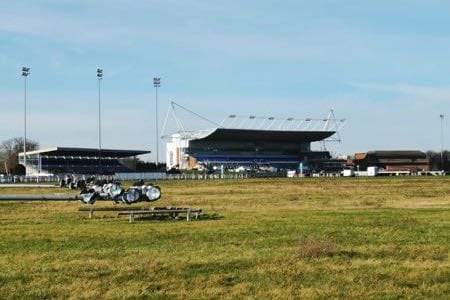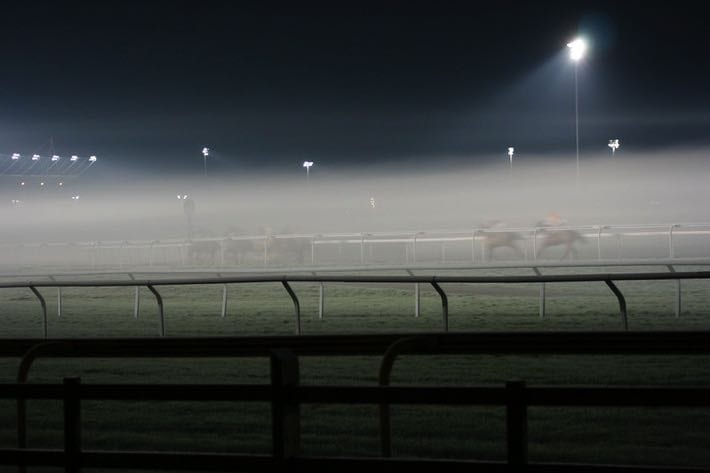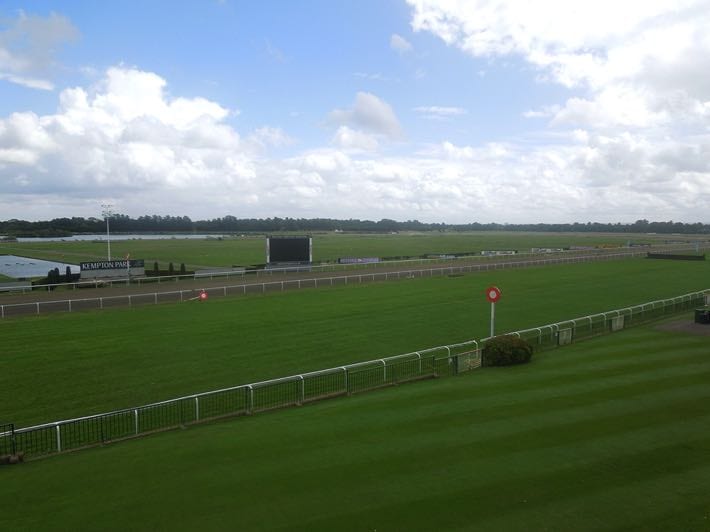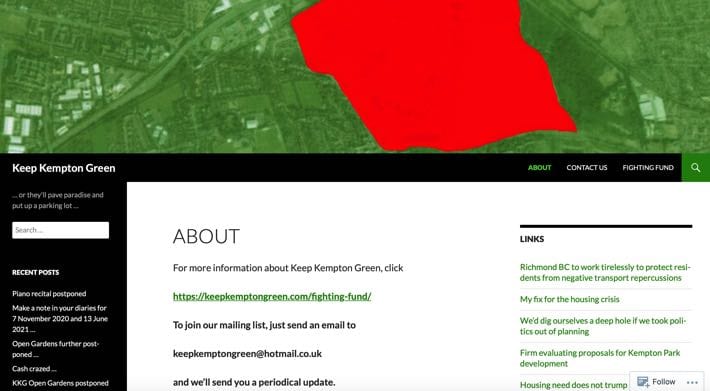
In January of 2017, a proposal was made to close Kempton Park Racecourse in order to use the space that it occupies for a new housing development. It was met with condemnation, with Jockey Club Racecourses, who owned the course at the time, being roundly criticised. The plan was for them to work in partnership with Redrow Homes in order to build about 3,000 houses on the 230-acre estate.
The plan was for racing to continue at Kempton Park until 2021 at the earliest, which gave those that objected to the development plenty of time to fight against it. Whilst the closure of the racecourse’s all-weather track was unlikely to make waves, the idea of losing the home of the King George VI Chase was keenly felt by many, so plans for the development ended up being shelved in November of 2019.
The Original Plans
Jockey Club Racecourses operated 15 tracks around the United Kingdom in January of 2017. One of those was Kempton Park Racecourse, which opened its doors for the first time in 1878 and was home to one of jump racing’s key events, the King George VI Chase. When it was announced that Kempton Park would be closed in order to become a housing development, the Jockey Club said that the King George would switch to Sandown Park.
The very idea of closing the racecourse was met with condemnation from numerous quarters. Henrietta Knight, who had seen both Best Mate and Edrenon Bleu win the race after she trained them in successive years, referred to the decision as ‘absolutely tragic’. It was described as a ‘great shame’ by Clive Smith, the owner of Kauto Star, who had won the race five times in his career and had a statue in the middle of the parade ring.
The notion of closing the course and allowing it to be used for redevelopment was part of the Jockey Club’s attempts to raise £500 million over a ten year period, with the aim being to use that money for investment. The racecourse itself would be replaced by about 3,000 new homes, built by Redrow. At the same time, the Jockey Club planned to build an all-weather course at Newmarket to replace the one that would be closed at Kempton Park.
The Jockey Club, for its part, insisted that the decision to close Kempton Park would only get the green light if more than £100 million could be raised by the sale of the racecourse and if Newmarket’s proposed all-weather course got the go-ahead. The latter would only be possible with approval from the British Horseracing Authority board, which promised to ‘work with’ the Jockey Club over the various proposals put forward.
What Happened Next

The objections to the idea of redeveloping Kempton Park were numerous and vociferous. Whilst there was plenty of opposition from within racing, it wasn’t even as if the plan was all that popular with locals either. Part of the objection came in the form of Kempton Park standing on green belt land, meaning that building houses should have been the last thing on anyone’s mind for the area.
From within the racing industry, there continued to be a sense of astonishment that the Jockey Club would allow one its most historic courses to be closed and developed in such a way, given that the organisation purports to have the best interests of racing in mind at all times. Champion trainer, Nicky Henderson, suggested that losing Kempton Park would be akin to driving a nail into the coffin of jump racing.
A report in February of 2018 suggested that Kempton Park was ‘strongly performing’ as part of the green belt area and that it would therefore be an ‘unlikely’ area to get the go-ahead for new housing. Those that objected to the whole thing from the start celebrated the news, essentially believing that Jockey Club Racecourses’ ‘act of vandalism’ was no longer likely or even able to happen, so they could breathe easy.
The reality, however, was that things were far from over. The site’s value had increased from about £460 million when the development plans were announced to more than £600 million when its value was assessed by the Ministry of Housing, Communities and Local Government. That was an amount that far outweighed Jockey Club Racecourses’ desire to raise £100 million, so their plans weren’t quite dead yet.
Plans Get Shelved
By November of 2019, it became clear that the possibility of having a ‘quick and easy’ sale of Kempton Park was over. Spelthorne council had asked for sites on which to build more than 15,000 new homes and Jockey Club Racecourses had put forward the course as one such suggestion, only for the idea to be greeted with objection after objection. When the Spelthorne Local Plan was published, the course wasn’t on the list.
The main reason for Kempton Park to be rejected as a possible site for housing was due to its position as part of the green belt, which the council believed it played an ‘integral role’ in. The Local Plan document stated, “The loss of this site from the green belt would risk the merging of Spelthorne with Greater London and this would also significantly alter the character of the area.” It’s not as if the possible benefits hadn’t been weighed up, with the document saying,
Overall the large scale of development would make a positive contribution to parts of the preferred spatial strategy as it would enable the council to deliver a significant quantum of homes in a reasonably sustainable location. A development of this size, through a master plan approach, would enable a holistic schemes to be designed with the opportunity to integrate it with the wider environment. Benefits have been identified from the proposed country park and provision of new community infrastructure.
Ultimately, though, it was decided that any potential benefits of using the racecourse were outweighed by the negative impact of doing so. The report said, “it has been concluded that the harm to the green belt is not outweighed by the proposed development. Discount from consideration. Do not take forward.” So, it was that the celebrations, which had been pre-emptive a year before, were taken up again by the scheme’s critics.
Housing Pressures Continued for Spelthorne

Within months of the council’s Local Plan stating that the racecourse was not going to be considered for development, newspaper reports began to emerge that suggested it wasn’t quite as clear cut as all that. A Spelthorne council meeting in December of 2019 saw the question of Kempton Park rear its head once again, with the Strategic Planning Manager, Ann Biggs, shooting down the idea of using it, but with caveats.
Biggs said, “We’re not proposing to allocate it for development. If we’ve adopted the local plan, and we’re meeting our need, then we’re as guaranteed as possible that we would be able to resist an application for a large housing development of Kempton.” The thing that was most likely to put the racecourse at risk of redevelopment was a delay in local planning or, worse, a plan that didn’t meet the housing needs of the government.
Around 1.6% of the borough’s green belt land was being considered for redevelopment because Spelthorne council felt that they were unable to meet the government’s ‘excessive’ housing targets without turning to the green belt land. The council was informed that it needed to build more than 600 homes every year between 2020 and 2035 in order to hit the targets that it had been presented with by the government.
It was under these pressures for new housing that Kempton Park seemed to be under continual threat of development, despite the scheme having seemingly been shelved a year before. Spelthorne council did not want to allow the racecourse to be sold for housing, given the importance of it to the local economy during the various jump racing meetings that took place there throughout the year.
Smaller Scale Development Proposed
On the fifth of February 2020, the Jockey Club released a statement announcing that a smaller scale residential development at the racecourse had been proposed. The Jockey Club, along with Redrow Homes, had submitted the proposals to the Spelthorne Borough Council’s Local Plan process, which would see racing able to continue at the course indefinitely at the same time as new houses being built.
Despite all of the criticism, it seemed as though the Jockey Club was unwilling to abandon its plans entirely for the reason that British racing remained in need of ‘major funding’ to ‘improve its long-term prospects’. The Jockey Club’s Board of Stewards decided that the long-term investment that would be gained from selling ‘all or part’ of Kempton Park outweighed the downsides of selling the course.
The proposed area put forward by the Jockey Club and Redrow Homes involved only areas of the course that had already been developed. The result of this was that all racing facilities would be maintained, including both the all-weather track and, of course, the jumps course. Whilst it wasn’t ideal, it was seen by the Jockey Club as a weigh of maintaining the sport in the long-term by using the money for investment.
Redrow Quits London

In the summer of 2020, Redrow Homes confirmed that it would scale back construction plans in London as a result of changes in policy because of the Covid-19 pandemic. Though it saw the developer move out of the capital, the firm did announce that it remained ‘committed to the redevelopment of Kempton Park’. Rather than 3,000 homes originally planned for, Redrow would instead build 550 new houses.
The piece is titled, “Is Kempton Park Still at Risk of Development?” and the answer to that question is ‘yes’. At the time of writing, Keep Kempton Green remains a going concern, with the campaign group still updating people about its opposition to the idea of building any housing whatsoever on the racecourse site. It saw the scaled down plans as an attempt to appease Jockey Club members rather than protect the green belt.
After all, the Jockey Club members’ main objection to the idea of development Kempton Park was at the idea of losing such a historic racecourse, rather than because of the loss of the local green belt land. The latter was very much a local issue, with those objecting aware of the fact that the Jockey Club put forward its smaller scale plans alongside the original plans for 3,000 new homes.
The fact that the global pandemic and the cessation of spectators attending sporting events in anything like the original numbers will have hit the Jockey Club and horse racing in general quite hard. The need to raise funds in order to cope with those losses is still there, meaning that the organisation is perhaps even more likely than ever to want to sell some of the land that owns for development. This story, then, is far from over.